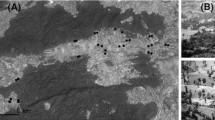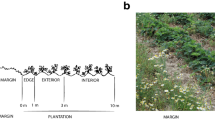Abstract
For the first time, the predatory arthropods of aubergine fields in South Sumatra, Indonesia, were studied by pitfall trapping and by square flooding in two four-week periods; first, early after transplanting, and second, during harvest. Plant cover and insecticide use were very low in the first (I) and high in the second period (II). In 20 pitfall traps were caught (I) 3,794, and (II) 2,875 specimens of predatory arthropods. The high number in period I was mainly due to Pheidole sp. The frequency of two predator groups decreased significantly from period I to period II, and further six groups showed the same tendency of decrease. But the frequency of 12 other predator groups increased from period I to II. Concerning the ants Pheidole sp. and Tapinoma sp., square samples revealed that apparently the temperature on bare soil stimulated a high activity and also a high abundance. Both species were not negatively affected by the insecticide sprays. In all, the effects of the seven weekly insecticide sprays on the epigeal predators proved to be low, presumably mainly due to the plant cover. The average predator numbers per m2 were 18.1 (with 5.8 mg/m2) (period I), and 70 (with 13.7 mg/m2) (period II). Over both periods, spiders were represented in traps/squares with 23.2/25.9 % of all predators, ants with 59.3/46.1 % and gryllids with 10.5/15.3 %. All other predator groups shared less than 10 %. Ants (Formicidae) were represented with 17 genera, spiders (Araneae) with ten families. The results are discussed concerning the low effect of the insecticides on the epigeal predators, and the effects of plant cover of soil.
Zusammenfassung
Zum ersten Mal wurden die räuberischen Arthropoden auf Auberginenfeldern in Süd-Sumatra mit Bodenfallen und einer Quadratmethode in zwei Perioden von je vier Wochen untersucht: erstens früh nach der Pflanzung (I) und zweitens während der Ernte (II). Die Pflanzenbedeckung des Bodens und der Einsatz von Insektiziden war in Periode I sehr gering, in Periode II aber sehr hoch. In 20 Bodenfallen wurden gefangen (I) 3794 und (II) 2875 Individuen räuberischer Arthropoden. Die hohe Zahl in Periode I war vorwiegend durch Pheidole sp. verursacht. Die Häufigkeit von zwei Räubergruppen nahm von Periode I nach II signifikant ab. Sechs weitere Gruppen zeigten die gleiche Tendenz, aber die Häufigkeit von weiteren 12 Gruppen nahm von Periode I nach II zu. Bei den Ameisen Pheidole sp. und Tapinoma sp. zeigte die Quadratmethode, dass offensichtlich die hohe Temperatur des kahlen (schwarzen) Bodens eine hohe Aktivität induzierte, die eine hohe Dichte simulierte. Beide Arten wurden nicht negativ durch die Insektizide beeinflusst. Im ganzen zeigten die sieben wöchentlichen Insektizidbehandlungen kaum Einflüsse auf die epigäischen Raubarthropoden. Die durchschnittliche Individuenzahl von Prädatoren pro m2 war 18,1 (mit 5,8 mg/m2) (Periode I) und 70 (mit 13,7 mg/m2) (Periode II). Über beide Perioden waren in Fallen/Quadraten die Spinnen mit 23,2/26,8 % repräsentiert, die Ameisen mit 59,3/46,1 % und die Grillen mit 10.5/15,3 %. Alle anderen Räubergruppen lagen unter 10 %. Ameisen (Formicidae) waren mit 17 Gattungen vertreten, die Spinnen (Araneae) mit 10 Familien. Die Ergebnisse werden im Hinblick auf die Insektizidwirkungen und die Auswirkungen der Bodenbedeckung diskutiert.
Similar content being viewed by others
Literature
Basedow, T. (1993): Predatory arthropods in cabbage terraces under different conditions in the Cordillera Region of Luzon, Philippines. Bull. Entomol. Res. 83, 313–319.
Basedow, T., Rzehak, H. (1988): Abundanz und Aktivitätsdichte epigäischer Raubarthropoden auf Ackerflächen — ein Vergleich. Zool. Jahrb. Syst. 115, 495–508.
Basedow, T., Rzehak, H., Voss, K. (1985): Studies on the effect of deltamethrin on the numbers of epigeal predatory arthropods occurring in arable fields. Pestic. Sci. 16, 325–331.
Basedow, T., Braun, C., Lühr, A., Naumann, J., Norgall, T., Yanes, G. (1991): Abundanz, Biomasse und Artenzahl epigäischer Raubarthropoden auf unterschiedlich intensiv bewirtschafteten Weizen- und Rübenfeldern: Unterschiede und ihre Ursachen. Ergebnisse eines dreistufigen Vergleichs in Hessen, 1985 bis 1988. Zool. Jahrb. Syst. 118, 87–116.
Basedow, T., Klinger, K., Froese, A., Yanes, G. (1988): Aufschwemmung mit Wasser zur Schnellbestimmung der Abundanz epigäischer Raubarthropoden auf Äckern. Pedobiologia 32, 317–322.
Basedow, T., Bernal-V, J. A. (2001): Epigäische Raubarthropoden in Tomatenfeldern in Panama. Mitt. Deut. Ges. Allg. Angew. Entomol. 13, 309–312.
Basedow, T., Boguslawski, C. von, El Shafie, H. A. F., Tadesse, A. (2004): Auftreten, Abundanz und Biomasse der epigäischen Raubarthropoden auf äckern in Nordost-Afrika (Ägypten, Sudan, Äthiopien). Entomol. heute 16, 141–148.
Basedow, T., Krull, S. (2005): The occurrence of weeds and the composition, abundance and biomass of the predatory arthropod community in newly sown maize fields in the Central Province of Papua New Guinea. Z. Pflanzenkrankh. Pflanzensch. — J. Plant Dis. Protect. 112, 304–311.
Dritschilo, W., Wanner, D. (1980): Ground beetle abundance in organic and conventional corn fields. Environ. Entomol. 9, 629–631.
Freude, H., Harde, K. W., Lohse, G. A. (1964): Die Käfer Mitteleuropas. Vol. 4, Staphylinidae I. Goecke und Evers, Krefeld, Germany.
Hölldobler, B., Wilson, E. O. (1990): The Ants. Springer, Berlin, Heidelberg, New York.
Nyffeler, M., Sterling, W. L., Dean, D. A. (1994): Insectivorous activities of spiders in United States field crops. J. Appl. Entomol. 118, 113–128.
Perfecto, I., Sediles, A. (1992): Vegetational diversity, ants (Hymenoptera: Formicidae), and herbivorous pests in a neotropical agroecosystem. Environm. Entomol. 21, 61–67.
Rzehak, H., Basedow, T. (1982): Die Auswirkungen verschiedener Insektizide auf die epigäischen Raubarthropoden in Winterrapsfeldern. J. Pest Science 55, 71–75.
Riechert, S. E., Lockley, T. (1984): Spiders as biological control agents. Annu. Rev. Entomol. 29, 299–320.
Rivney, E., Ziv, M. (1963): A contribution to the biology of Gryllus bimaculatus in Israel. Bull. Entomol. Res. 54, 37–43.
Roberts, M. J. (1995): Spiders of Britain and Northern Europe. Harper Collins, London.
Schmutterer, H. (1969): Pests of Crops in Northeast and Central Africa, with Particular Reference to the Sudan. Gustav Fischer, Stuttgart.
Shepard, B. M., Barrion, A. T., Litsinger, J. A. (1987): Friends of the Rice Farmer — Helpful Insects, Spiders, and Pathogens. International Rice Research Institute, Los Baños, Philippines.
Soerjani, M., Kostermans, A. J. G. H., Tjitrosoepomo, G. (1987): Weeds of Rice in Indonesia. Balai Pustaki, Jakarta.
Sunderland, K. D., Crook, N. E., Stacey, D. L., Fuller, B. J. (1987): A study of feeding by polyphagous predators on cereal aphids using ELISA and gut dissection. J. Appl. Ecol. 24, 907–933.
Thiele, H. U. (1977): Carabid Beetles in their Environment. Springer, Berlin, Heidelberg, New York.
Trautner, J., Geigenmüller, K. (1987): Tiger Beetles, Ground beetles. Illustrated key to the Cicin-delidae and Carabidae of Europe. Joseph Margraf, Aichtal, Germany.
Wilkinson, J. D., Beaver, K. D., Ignoffo, C. M. (1975): Contact toxicity of some chemical and biological pesticides to several insect parasitoids and predators. Entomophaga 20, 113–120.
Author information
Authors and Affiliations
Corresponding author
Rights and permissions
About this article
Cite this article
Basedow, T., Waruwu, Y. & Arinafril The epigeal predatory arthropods in aubergine fields at South Sumatra (Indonesia) with regard to the plant cover and the use of insecticides. J Plant Dis Prot 112, 573–579 (2005). https://doi.org/10.1007/BF03356154
Received:
Accepted:
Published:
Issue Date:
DOI: https://doi.org/10.1007/BF03356154




